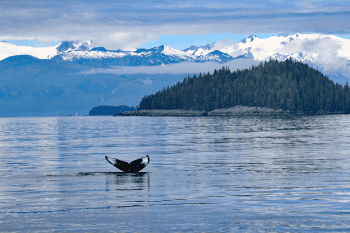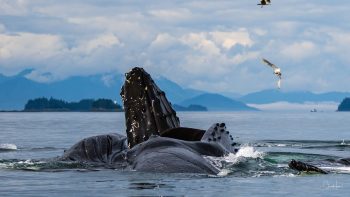Humpback Whales
Exciting. Awesome. Beautiful. These are some of the words our passengers use to describe our encounters with humpback whales. Here is an account:
Humpbacks are a common sight on our cruises. Sometimes they are spotted moving slowly against the shoreline. At other times they are very active at the surface, performing exciting behaviors such as fluke slaps, tail lobs, flipper slaps, and breaches.

Focus on Whales Cruise – Humpback Whale By Danny Yates
Humpbacks come to Alaska for the bounty of food found here. They migrate from warm, tropical Hawaiian calving and breeding waters arriving in May and staying until October. Watching humpback whales feed is surely one of nature’s most amazing spectacles.
Humpbacks gorge themselves on tiny shrimp-like creatures and small fish in these nutrient rich waters. They are for the most part seasonal feeders. Can you imagine eating for only five or six months a year and living off reserves for the remainder? When they are feeding, they consume about a ton of food each day helping them to build the blubber reserves needed for the rest of the year.
Humpbacks feed by taking in large mouthfuls of both prey and water. As they break the surface, their throat expands tremendously, gorged with both food and water. Here’s how lunge feeding whales look as they break the surface. As the whales close their mouths, they squeeze the water out the sides of the mouth through a built in filter called baleen. Once the water is strained through the baleen, only the food remains in the mouth. It is then swallowed with the help of a massive, two-ton tongue.
Humpbacks can be quite clever when it comes to feeding. To concentrate their prey, they use a strategy called bubble-netting, sometimes cooperating in groups of 20 or more. They begin at the surface, blowing to replace air reserves before diving. They locate the prey and begin herding them toward the surface. They emit a feeding call which scares the prey into a tighter group. And to ensure the concentration of the prey, one whale begins to release air bubbles through its blowhole while spiraling towards the surface. This results in a circle of bubbles rising towards the surface, entrapping the prey. Rising through the middle of the bubble ring, they lunge at the prey as they break the surface.
Listen to a Humpback Whale Feeding Call!

copyright Gina Ruttle
One of the most amazing of Humpback whale behaviors is the cooperative ‘bubble-net’ feeding lunge. This fascinating forage technique is unique to the humpbacks within certain areas of Southeast Alaska and one of the whales’ activities that we specialize in finding for our clients. It’s an incredible sight to observe and/or capture with a camera!
Prior to the group of whales erupting in unison through the seas surface, Alaska Adventurer’s hydrophone enables us to hear the humpback’s enthralling feeding call which helps to herd the herring or krill into the whales’ bubble-net trap. Here you can listen to a recording we made of this spine chilling song
Read more about Hungry Humpbacks here.
Humpback whales
“The whales were a mystical, spiritual experience!”
Kris & Rick L.
San Carlos, CA


